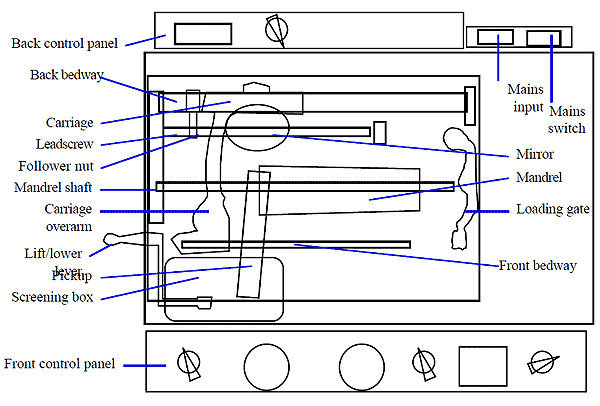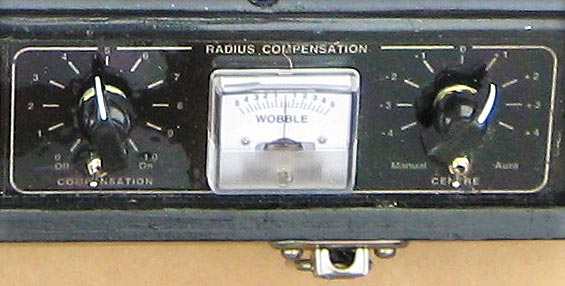
 |
Version: April 9, 2012 |
|
This is a very sturdy player, built on a Columbia / Dictaphone cylinder shaving machine with a cast iron bedplate. It is mounted on a wooden box containing motors, controls and amplifier. Altogether the player weighs in at 30 kg. The mandrel and the feedscrew are each driven by a stepping motor. This means the motion of the mandrel and the feedscrew are separate and independent. Stepping motors being what they are, Mr.Tuddenham has devised a three-stage way of avoiding any unevenness in the motion being transferred to the mandrel and feedscrew: first, the current driving the motors is given a special waveform designed to make the motion even. Second, there is a resilient torsional coupling to the drive wheel and finally, the two drive belts are made from high damping coefficient material. In order to reduce vibrations, the motors are also mounted on weighted bedplates that are isolated both from the motors and from the machine structure by double sets of resilient mountings. The mandrel fits standard cylinders of up to 178 mm length and up to 76 mm diameter. The motor gives it a speed range of 10 - 200 rpm. Mandrels can be exchanged as one unit along with shaft, drive pulley and collar. The tone arm assembly is driven by the original feedscrew at speeds of up to 230 mm per minute. The tone arm is made of thin aluminium laminated with plywood, which prevents unwanted resonance. It is fitted with a Shure 44 cartridge, which can be given a tracking weight of 2 - 6.5 grams by moving the counterbalance weight. It has a lever operated manual lift mechanism that slows the movement near the cylinder surface for increased precision. The tone arm sits on top of a moving box containing preamplifiers and motion sensors. Sideways motion produced by the advancing groove on the cylinder is detected by photo diodes reacting to the light from two LEDs being covered or uncovered by a shutter attached to the tone arm. The resulting signal is used to change the speed of the feedscrew motor to keep up with the cylinder.
|

|
The most special feature of this player is the anti-wow, or radius compensation system. It is designed to reduce the wow produced in the sound of eccentric or oval cylinders. It works on the principle of sensing the difference in radius of the cylinder, which gives a higher surface speed, and thus a higher pitch, in the parts of the cylinder with the larger radius. The compensation acts on the mandrel drive motor, reducing its speed in proportion to the increase in radius, thus keeping the surface speed (and the pitch) constant. The information to guide the mandrel drive motor comes from a goniometer in the tone arm assembly. This consists of two coils, one around the vertical axis, and one in the tone arm, perpendicular to the first coil. As the tone arm moves up and down, the angle between the coils will change. The vertical coil is fed an electric signal of about 45 kHz, which is picked up by the horizontal coil, where the amplitude and polarity will depend on the elevation angle of the tone arm. This signal is used to generate a control signal for the mandrel motor. The goniometer signal needs to be calibrated for each cylinder. Set the mandrel speed selector to Creep to let the cylinder spin at a slower speed. Then, using the Centre control, set the needle of the Wobble dial to swing equally to both sides of zero. Then, at full mandrel speed, set the required amount of compensation by turning the Compensation control. The compensation signal can be turned on and off for comparison with a switch.
|

|
The player gives different types of output from the preamplifiers. There is right channel, left channel and mono as an untreated signal with a bandwidth of 20 - 20,000 Hz. The mono signal is normally wired for vertically modulated cylinders, but it can be changed to lateral modulation with a switch. There is also an equalised mono signal with rumble filtering. Christer Hamp, 2012
|

| Write to Adrian Tuddenham: | Read the manual: | Visit Adrian's site: | |
